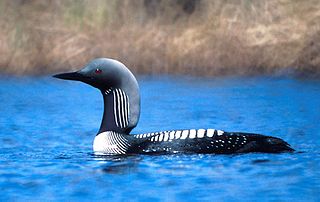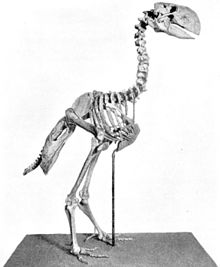
The Cenozoic Era meaning "new life" is the current and most recent of the three geological eras of the Phanerozoic Eon. It follows the Mesozoic Era and extends from 66 million years ago to the present day. It is generally believed to have started on the first day of the Cretaceous–Paleogene extinction event when an asteroid hit the earth.

Gaviiformes is an order of aquatic birds containing the loons or divers and their closest extinct relatives. Modern gaviiformes are found in many parts of North America and northern Eurasia, though prehistoric species were more widespread.

A ratite is any of a diverse group of flightless and mostly large and long-legged birds of the infraclass Palaeognathae. Kiwi, however, are relatively much smaller and shorter-legged, as well as being the only nocturnal ratites.

The rails, or Rallidae, are a large cosmopolitan family of small- to medium-sized, ground-living birds. The family exhibits considerable diversity and includes the crakes, coots, and gallinules. Many species are associated with wetlands, although the family is found in every terrestrial habitat except dry deserts, polar regions, and alpine areas above the snow line. Members of the Rallidae occur on every continent except Antarctica. Numerous island species are known. The most common rail habitats are marshland and dense forest. They are especially fond of dense vegetation.

The ostriches are a family, Struthionidae, of flightless birds. The two extant species of ostrich are the common ostrich and Somali ostrich, both in the genus Struthio, which also contains several species known from Holocene fossils such as the Asian ostrich. The common ostrich is the more widespread of the two living species, and is the largest living bird species. Other ostriches are also among the largest bird species ever.
Neoliotomus is a genus of North American mammal from the Paleocene. It existed in the age immediately following the extinction of the last dinosaurs and was a member of the extinct order Multituberculata. It lies within the suborder Cimolodonta and the superfamily Ptilodontoidea. Other than that, its affinities are somewhat unclear.
Parectypodus is a genus of extinct mammal that lived from the Paleocene to the Eocene of North America. Some of the known fossil material may also be from the Upper Cretaceous. It was named by G.L. Jepsen in 1930.
Prochetodon is a genus of mammals from the extinct order Multituberculata. It lived during the Upper Paleocene and the Lower Eocene in North America. The genus was formally named by G. L. Jepsen in 1940.
Microcosmodon is a mammal genus from the Paleocene of North America. It was a member of the extinct order Multituberculata, and lies within the suborder Cimolodonta and family Microcosmodontidae. The genus Microcosmodon was named by G.L. Jepsen in 1930.

The mousebirds are a family of birds. They are the sister group to the clade Eucavitaves, which includes the cuckoo roller (Leptosomiformes), trogons (Trogoniformes), Bucerotiformes, Coraciformes and Piciformes. The mousebirds are therefore given order status as Coliiformes. This group is now confined to sub-Saharan Africa, and it is the only bird order confined entirely to that continent, with the possible exception of Turacos which are considered by some as the distinct Order Musophagiformes. Mousebirds had a wider range in prehistoric times, with a widespread distribution in Europe and North America during the Paleocene.

Gastornis is an extinct genus of large flightless birds that lived during the late Paleocene and Eocene epochs of the Cenozoic era. The genus is currently thought to contain three or four distinct species, known from incomplete fossil remains, found in western-central Europe. More complete specimens are known from a fourth, North American species, which had previously been classified in the distinct genus Diatryma. Many scientists now consider Diatryma to be so similar to the other species of Gastornis that it should also be included in that genus. A fifth species, also previously classified in its own genus, is known from China.

Struthio is a genus of bird in the order Struthioniformes. There are two living species, the common ostrich and the Somali ostrich.

The subfamily Indricotheriinae are a group of long-limbed, hornless rhinoceroses commonly known as the paraceratheres that evolved in the Eocene epoch and lived until the early Miocene. The first paraceratheres were only about the size of large dogs, growing progressively larger in the late Eocene and Oligocene. They were most common in the rainforest floodplain region which is now Kazakhstan, India, and southwest China, and lived further inland throughout northern and central Asia as well.

Oxyaenidae is a family of carnivorous mammals. Traditionally classified in Creodonta, this group may be related to pangolins. The group contains four subfamilies comprising thirteen genera. North American oxyaenids were the first creodonts to appear during the late Paleocene, while smaller radiations of oxyaenids in Europe and Asia occurred during the Eocene. They were superficially cat-like beasts that walked on flat feet, in contrast to modern cats, which walk or run on their toes. Anatomically, characteristic features include a short, broad skull, deep jaws, and teeth designed for crushing rather than shearing, as in the hyaenodonts or modern cats.(Lambert, 163)
The Paleocene, or Palaeocene, is a geological epoch that lasted from about 66 to 56 million years ago (mya). It is the first epoch of the Paleogene Period in the modern Cenozoic Era. The name is a combination of the Ancient Greek palæo- meaning "old" and the Eocene Epoch, translating to "the old part of the Eocene".

Tillodontia is an extinct suborder of eutherian mammals known from the Early Paleocene to Late Eocene of China, the Late Paleocene to Middle Eocene of North America where they display their maximum species diversity, the Middle Eocene of Pakistan, and the Early Eocene of Europe. Leaving no descendants, they are most closely related to the pantodonts, another extinct group. The tillodonts were medium- to large-sized animals that probably feed on roots and tubers in temperate to subtropical habitats.

Paleontology in Wyoming includes research into the prehistoric life of the U.S. state of Wyoming as well as investigations conducted by Wyomingite researchers and institutions into ancient life occurring elsewhere. The fossil record of the US state of Wyoming spans from the Precambrian to recent deposits. Many fossil sites are spread throughout the state. Wyoming is such a spectacular source of fossils that author Marian Murray noted in 1974 that "[e]ven today, it is the expected thing that any great museum will send its representatives to Wyoming as often as possible." Murray has also written that nearly every major vertebrate paleontologist in United States history has collected fossils in Wyoming. Wyoming is a major source of dinosaur fossils. Wyoming's dinosaur fossils are curated by museums located all over the planet.

The Odontoanserae is a proposed clade that includes the family Pelagornithidae and the clade Anserimorphae. The placement of the pseudo-toothed birds in the evolutionary tree of birds has been problematic, with some supporting the placement of them near the orders Procellariformes and Pelecaniformes based on features in the sternum.
Across the latter stages of the Cretaceous and most of the Paleocene, the Indian subcontinent remained an isolated landmass as it drifted across the Tethys Ocean, forming the Indian Ocean. The process of India's separation from Madagascar first began 88 million years ago, but complete isolation only occurred towards the end of the Maastrichtian, a process that has been suggested to be the creation of the Deccan Traps. Soon after, the land mass moved northward rather quickly, until contact with Asia was established 55 million years ago. Even then, both landmasses didn't become fully united until around 35 million years ago, and periods of isolation occurred as recently as 24 million years ago.
Wyonycteris is a genus of small mammals that existed in the late Paleocene and early Eocene epochs. The type species is Wyonycteris chalix, which lived in Wyoming during the Clarkforkian North American Land Mammal Age of the Paleocene and was originally proposed to be an early form of insectivorous bat. Later re-examination of the material has put this alliance in doubt, and the genus has instead been proposed as belonging to the subfamily Placentidentinae, within the family Nyctitheriidae. Similar fossil material of the same time period found in Europe was later discovered and described as new species, Wyonycteris richardi.













